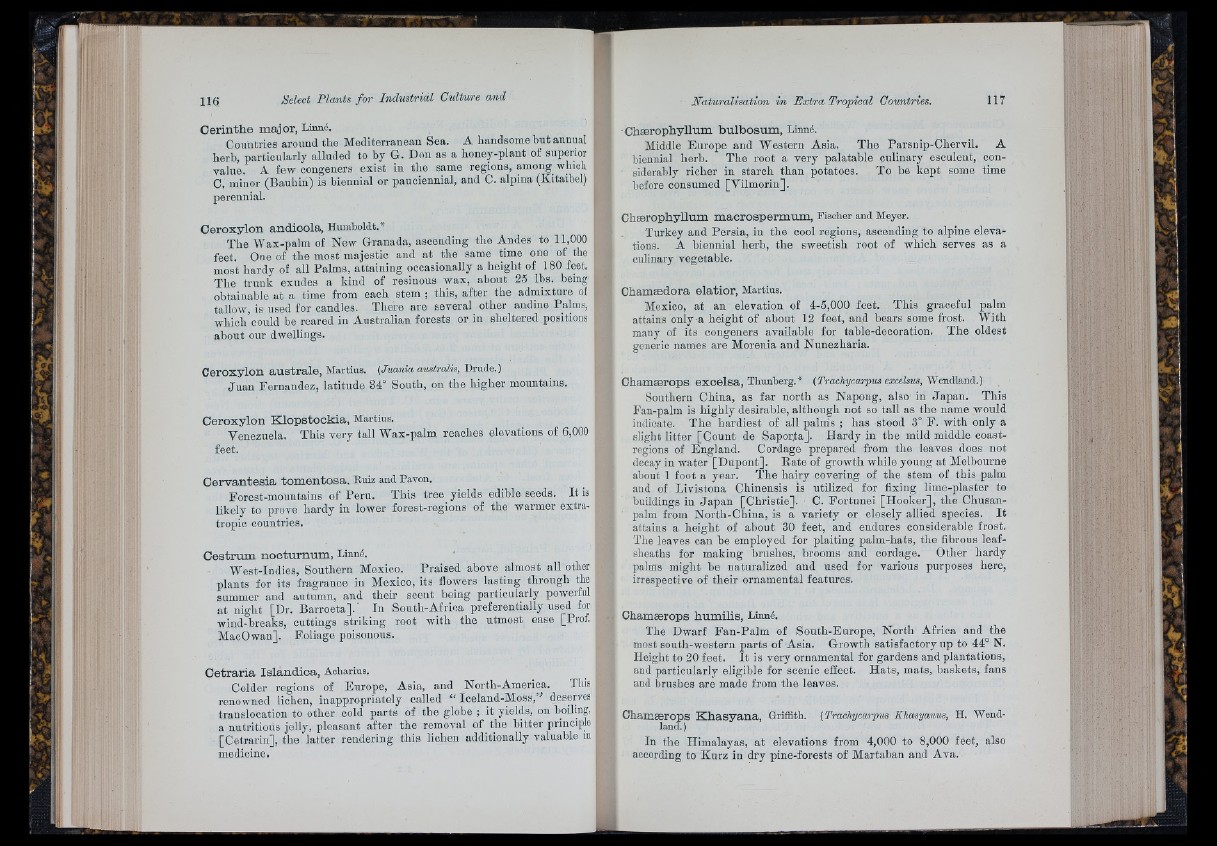
Select Plants fo r Industrial Culture and
C e r in th e m a jo r , Linné.
Countries around the Mediterranean Sea. A handsome but annual
herb, particularly alluded to by G. Don as a honey-plant of superior
value. A few congeners exist in the same regions, among whicli
C, minor (Bauhin) is biennial or pauoiennial, and C. alpina (Kitaibel)
perennial.
C e r o x y lo n a n d io o la , Humboldt.*
The Wax-palm of New Granada, ascending the Andes to 11,000
feet. One of the most majestic and a t the same time one of the
most hardy of all Palms, attaining occasionally a height of 180 feet,
The trunk exudes a kind of resinous wax, about 25 lbs. being .
obtainable at a time from each stem ; this, after the admixture of
tallow, is used for candles. There are several other andine Palms,
which could be reared in Australian forests or in sheltered positions
about our dwellings.
C e ro x y lo n a u s t r a l e , Martius. {Juania australis, Drude.)
Ju an Pernandez, latitude 84° South, on the higher mountains.
C e ro x y lo n K lo p s to o k i a , Martius.
Venezuela. This very tall Wax-palm reaches elevations of 6,000
feet.
C e r v a n t e s i a to m e n to s a . Ruiz and Pavon.
Forest-moiintains of Peru. This tree yields edible seeds. I t is
likely to prove hardy in lower forest-regions of the warmer extratropic
countries.
O e s t r u m n o c tu r n u m , Linné.
West-Indies, Southern Mexico. Praised above almost all other
plants for its fragrance in Mexico, its flowers lasting through the
summer and autumn, aud their scent being particularly powerful
at night [Dr. Barroeta].' In South-Africa preferentially used for
wind-breaks, cuttings striking root with the utmost ease [Prof.
MacOwan]. Foliage poisonous.
C e t r a r i a I s l á n d ic a , Acharius.
Colder regions of Europe, Asia, and North-America. This
renowned lichen, inappropriately called “ loeland-Moss,” deserves
translocation to other cold parts of the globe ; it yields, on boiling,
a nutritious jelly, pleasant after the removal of the bitter principle
[Cetrarin], the latter rendering this lichen additionally valuable in
medicine.
Naturalisation in Extra Tropical Countries.
C h æ ro p h y llum b u lb o s u m , Linné.
Middle Europe and Western Asia. The Parsnip-Chervll. A
biennial herb. The root a very palatable culinary esculent, considerably
richer in starch than potatoes. To be kept some time
before consumed [Vilmorin].
C h æ ro p h y llum m a c r o s p e rm u m , Fischer and Meyer.
Turkey and Persia, in the cool regions, ascending to alpine elevations.
A biennial herb, the sweetish root of which serves as a
culinary vegetable.
C h am æ d o ra e la tio r , Martins.
Mexico, at an elevation of 4-5,000 feet. This graceful palm
attains only-a height of about 12 feet, and bears some frost. With
many of its congeners available for table-decoration. The oldest
generic names are Morenia and Nunezharia.
C h am æ ro p s e x c e ls a , Thunberg.* (Traehycarpus exceUus, N enSUrià.)
Southern China, as far north as Napong, also in Japan. This
Fan-palm is highly desirable, although not so tall as the name would
indicate. The hardiest of all palnis ; has stood 3° F. with only a
slight litter [Count de Sapor.ta]. Hardy in the mild middle coast-
regions of England. Cordage prepared from the leaves does not
decay in water [Dupont], Bate of growth while young at Melbourne
about 1 foot a year. The hairy covering of the stem of this palm
and of Livistona Chinensis is utilized for fixing lime-plaster to
buildings in Jap an [Christie]. C. Fortunei [Hooker], the Chusan-
palm from North-China, is a variety or closely allied species. I t
attains a height of about 30 feet, and endures considerable frost.
The leaves can be employed for plaiting palm-hats, the fibrous leaf-
sheaths for making brushes, brooms and cordage. Other hardy
palms might he naturalized and used for various purposes here,
irrespective of their ornamental features.
Chamærops humiBs, Linné.
The Dwarf Fan-Palm of South-Europe, North Africa and the
most south-western parts of Asia. Growth satisfactory up to 44° N.
Height to 20 feet. I t is very ornamental for gardens and plantations,
and particularly eligible for scenic effect. Hats, mats, baskets, fans
and brushes are made from the leaves.
'i , ’i
Chamærops K h a s y a n a , Griffith,
land. )
( Tracliy carpus H. Wend-
In the Himalayas, a t elevations from 4,000 to 8,000 feet, also
according to Kurz in dry pine-forests of Martaban and Ava.